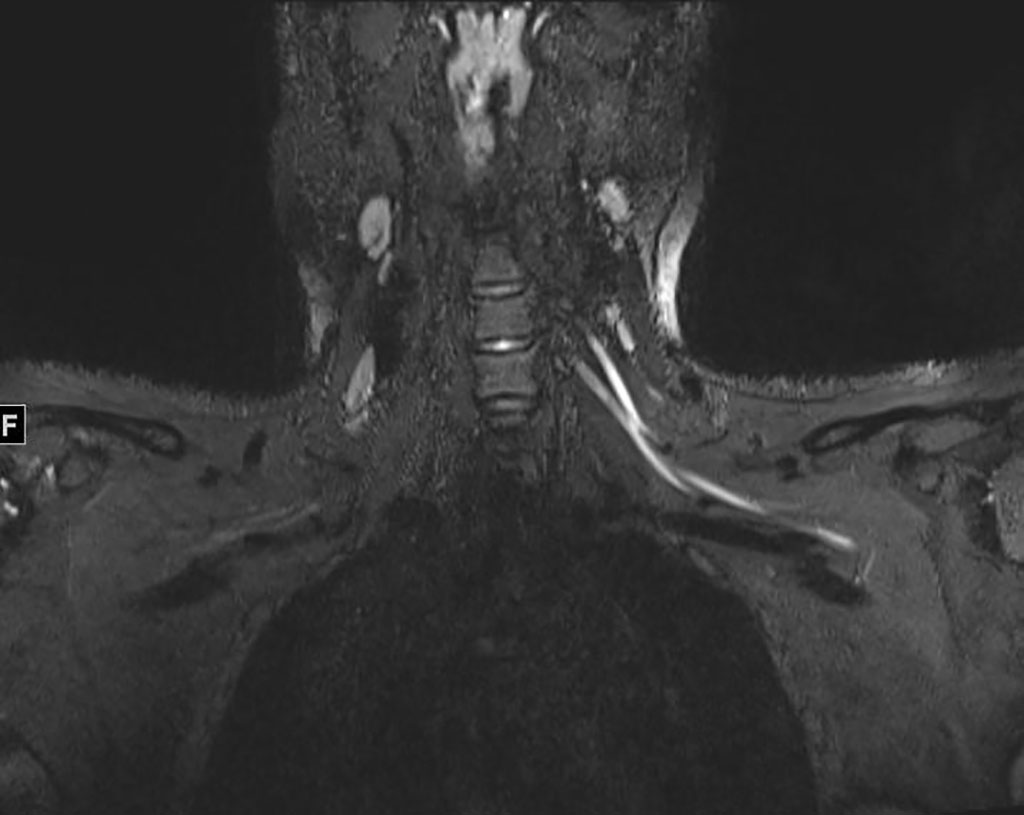Advanced Imaging Techniques Can Help Identify and Treat Nerve Damage in COVID-19 Patients, Finds Study
By MedImaging International staff writers
Posted on 03 Dec 2020
A new study has shown how advanced imaging technology can pinpoint what may have caused nerve damage in COVID-19 patients and help determine the best course of treatment.Posted on 03 Dec 2020
After recovering from COVID-19, some patients are left with chronic, debilitating pain, numbness or weakness in their hands, feet, arms and legs due to unexplained nerve damage. In the study, researchers from the Northwestern Medicine (Chicago, IL, USA) have demonstrated how advanced imaging techniques can help physicians identify and treat nerve damage in COVID-19 patients.

Image: An MR image of a patient in their early 20s shows nerve injury of the left brachial plexus in the neck (Photo courtesy of Northwestern University)
During their previous research, the researchers had found that COVID-19 patients can experience nerve damage after being flipped onto their stomachs (prone positioning) in the ICU as a life-saving measure to help them breathe. Their new study demonstrates how advanced imaging aids this cohort of patients as well as two additional patient cohorts with COVID-19-related nerve damage: secondary to an inflammatory immune response that attacked the nerves or from a hematoma (when blood collects outside of the blood vessels).
The imaging described in the study includes ultra-high-resolution ultrasound and MR neurography (MRI of peripheral nerves, which impact the arms and legs). They can help localize where a patient's problem is, show the severity of nerve damage, how many nerves are affected and if the nerve damage also has impacted the muscles. The advanced ultrasound technology is new, portable, less expensive and can sometimes be even better at detecting nerve damage than MRI. Ultrasound also can be performed on patients who are unable to tolerate MR imaging.
If imaging technology discovers nerve damage caused by stretch injury because of prone positioning, that patient may be referred to a physician who specializes in rehabilitation or peripheral nerve surgery. If imaging finds nerve damage due to an inflammatory response, the patient may be better served by seeing a neurologist. If imaging reveals nerve damage from a hematoma, blood thinner medications would have to be adjusted immediately and the patient may even have to see a surgeon. For COVID-19 patients and survivors with neuromuscular complications or "long-hauler" symptoms, imaging can help reveal the problem and guide further treatment.
"Let's say you have numbness in your fingers. That might actually be due to problems in your neck, elbow or wrist, and the best way to figure it out is with an MRI or ultrasound," said lead author Dr. Swati Deshmukh, assistant professor of radiology at Northwestern University Feinberg School of Medicine and a Northwestern Medicine radiologist. "We offer advanced imaging that shows even really, really small nerves, which helps us localize where the problem is, assess the severity and suggest what might be causing it."
"I want physicians and patients to be aware of the diagnostic options available due to recent innovations in technology, and inquire if advanced imaging might be right for them," added Dr. Swati Deshmukh.
Related Links:
Northwestern Medicine














